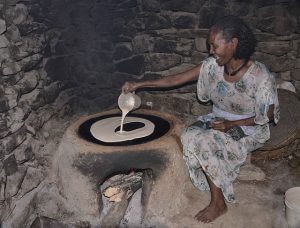9 Teff: Injera
Those who grow food do not always have food.

Injera is a spongy sourdough flatbread eaten in Ethiopia and Eritrea, but now has gained popularity in the United States. Injera is made of teff, a cereal grain, that makes up the livelihoods and stable foods of a vast majority of Ethiopian and Eritrean farmers. Teff and injera is vital to ensuring food security in a nation amok with poverty and controlled by international corporations.
Teff, now considered a “superfood”, is rightly named. High in protein, calcium and minerals, it provides for much of the nations’ needed nutrient supplies, along with its wonderful uses as a form of utensil, plates and, even, construction materials and animal feed. And yet, with so many farmers growing teff, they still face problems of food insecurity.

Teff farmers in Ethiopia and Eritrea continue to grow teff, and eat teff. The teff they grow and the teff they eat are not the same. The rise of teff as a “superfood” in the US in the late 20th century resulted in a teff production in the Midwest and Southeastern states. To meet demands and earn profits, international corporations have entered Western Africa to control the teff production for exports, until the farmers themselves can no longer supply for themselves or afford to buy the result of their hard labour.
Now comes the truly ironic part. US food aid supplies food to areas of West Africa facing food insecurity. They try to mimic local food preferences and cultures. In doing so, it closes the loop – US is sending food aid in the form of teff right to the teff farmers in Ethiopia and Eritrea. Unfortunately, this is not an unique case – the same can be said of quinoa, another “superfood” from the South American countries of Peru and Bolivia.
Play Your Part:
- If possible, buy from your local teff farmers and suppliers
- Learn about the role of trade and politics in our food system. Check out Enough by Thurow and Kilman on US food aid.
I will admit I have never been to Ethiopia and Eritrea where authentic injera can be eaten. I have only eaten injera in the United States, at restaurants run by Ethiopians, and I really enjoyed it! It has a nice spongy and sour-ish taste to it, that soaks up the flavours of whatever dish is placed on top it. Below is a recipe for making injera, so be sure to look up recipes to pair with it (my recommendation is Doro Wat, spicy chicken stew).

Injera (from Daring Gourmet)
Yield: Serves 6
Ingredients:
- 2 cups teff flour
- water
- yeast (optional – read notes for details)
Directions:
- Mix teff flour with water. Add yeast if desired
- Loosely cover with cheesecloth (or plastic wrap), and let sit undisturbed at room temperature for 4-5 days
- Pour out top layer (if without yeast) and as much liquid as possible. The result should be a clay-like batter
- Stir batter
- Bring 1 cup water to boil, and stir in 1/2 cup batter until mixture thickens
- Stir the cooked/thickened batter back into the original mixture
- Add roughly 2/3 cup water, until consistency is that of crepe batter. The batter should have a sweet-soured nutty smell
- Heat a non-stick pan on medium and coat surface with injera batter (thicker than crepe, thinner than pancake)
- Continue to cook, allowing bubbles to pop
- Cover pan and turn off heat, letting injera steam cook for a few more minutes
- Repeat Steps 8-10 to finish batter
- Place stews, curries or other dishes on top the injera and serve warm
Recipe Notes:
- Yeast or no yeast? Commercial yeast prevents the formation of wild yeast, which will result in a moody-looking top layer after fermentation. However, wild yeast produces a richer, more complex flavour. If you are able to tolerate the moldiness, going with wild yeast is recommended (don’t worry, the mold layer will be taken off!)
